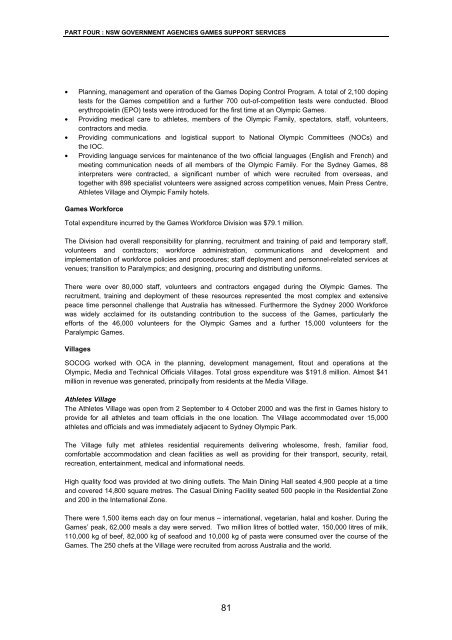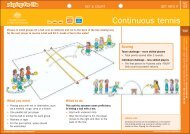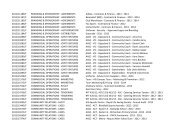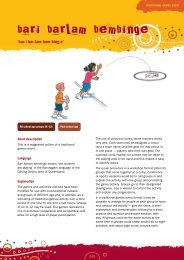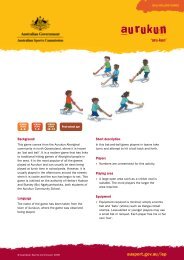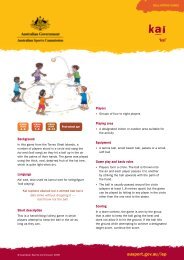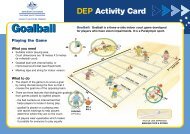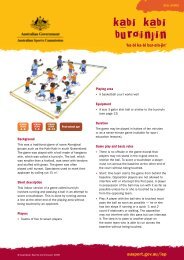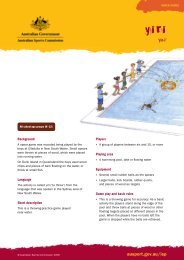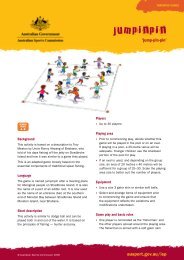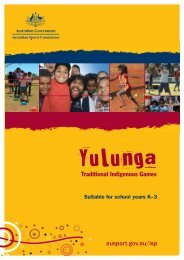the sydney 2000 olympic and paralympic games - Australian Sports ...
the sydney 2000 olympic and paralympic games - Australian Sports ...
the sydney 2000 olympic and paralympic games - Australian Sports ...
You also want an ePaper? Increase the reach of your titles
YUMPU automatically turns print PDFs into web optimized ePapers that Google loves.
PART FOUR : NSW GOVERNMENT AGENCIES GAMES SUPPORT SERVICES<br />
• Planning, management <strong>and</strong> operation of <strong>the</strong> Games Doping Control Program. A total of 2,100 doping<br />
tests for <strong>the</strong> Games competition <strong>and</strong> a fur<strong>the</strong>r 700 out-of-competition tests were conducted. Blood<br />
erythropoietin (EPO) tests were introduced for <strong>the</strong> first time at an Olympic Games.<br />
• Providing medical care to athletes, members of <strong>the</strong> Olympic Family, spectators, staff, volunteers,<br />
contractors <strong>and</strong> media.<br />
• Providing communications <strong>and</strong> logistical support to National Olympic Committees (NOCs) <strong>and</strong><br />
<strong>the</strong> IOC.<br />
• Providing language services for maintenance of <strong>the</strong> two official languages (English <strong>and</strong> French) <strong>and</strong><br />
meeting communication needs of all members of <strong>the</strong> Olympic Family. For <strong>the</strong> Sydney Games, 88<br />
interpreters were contracted, a significant number of which were recruited from overseas, <strong>and</strong><br />
toge<strong>the</strong>r with 898 specialist volunteers were assigned across competition venues, Main Press Centre,<br />
Athletes Village <strong>and</strong> Olympic Family hotels.<br />
Games Workforce<br />
Total expenditure incurred by <strong>the</strong> Games Workforce Division was $79.1 million.<br />
The Division had overall responsibility for planning, recruitment <strong>and</strong> training of paid <strong>and</strong> temporary staff,<br />
volunteers <strong>and</strong> contractors; workforce administration, communications <strong>and</strong> development <strong>and</strong><br />
implementation of workforce policies <strong>and</strong> procedures; staff deployment <strong>and</strong> personnel-related services at<br />
venues; transition to Paralympics; <strong>and</strong> designing, procuring <strong>and</strong> distributing uniforms.<br />
There were over 80,000 staff, volunteers <strong>and</strong> contractors engaged during <strong>the</strong> Olympic Games. The<br />
recruitment, training <strong>and</strong> deployment of <strong>the</strong>se resources represented <strong>the</strong> most complex <strong>and</strong> extensive<br />
peace time personnel challenge that Australia has witnessed. Fur<strong>the</strong>rmore <strong>the</strong> Sydney <strong>2000</strong> Workforce<br />
was widely acclaimed for its outst<strong>and</strong>ing contribution to <strong>the</strong> success of <strong>the</strong> Games, particularly <strong>the</strong><br />
efforts of <strong>the</strong> 46,000 volunteers for <strong>the</strong> Olympic Games <strong>and</strong> a fur<strong>the</strong>r 15,000 volunteers for <strong>the</strong><br />
Paralympic Games.<br />
Villages<br />
SOCOG worked with OCA in <strong>the</strong> planning, development management, fitout <strong>and</strong> operations at <strong>the</strong><br />
Olympic, Media <strong>and</strong> Technical Officials Villages. Total gross expenditure was $191.8 million. Almost $41<br />
million in revenue was generated, principally from residents at <strong>the</strong> Media Village.<br />
Athletes Village<br />
The Athletes Village was open from 2 September to 4 October <strong>2000</strong> <strong>and</strong> was <strong>the</strong> first in Games history to<br />
provide for all athletes <strong>and</strong> team officials in <strong>the</strong> one location. The Village accommodated over 15,000<br />
athletes <strong>and</strong> officials <strong>and</strong> was immediately adjacent to Sydney Olympic Park.<br />
The Village fully met athletes residential requirements delivering wholesome, fresh, familiar food,<br />
comfortable accommodation <strong>and</strong> clean facilities as well as providing for <strong>the</strong>ir transport, security, retail,<br />
recreation, entertainment, medical <strong>and</strong> informational needs.<br />
High quality food was provided at two dining outlets. The Main Dining Hall seated 4,900 people at a time<br />
<strong>and</strong> covered 14,800 square metres. The Casual Dining Facility seated 500 people in <strong>the</strong> Residential Zone<br />
<strong>and</strong> 200 in <strong>the</strong> International Zone.<br />
There were 1,500 items each day on four menus – international, vegetarian, halal <strong>and</strong> kosher. During <strong>the</strong><br />
Games’ peak, 62,000 meals a day were served. Two million litres of bottled water, 150,000 litres of milk,<br />
110,000 kg of beef, 82,000 kg of seafood <strong>and</strong> 10,000 kg of pasta were consumed over <strong>the</strong> course of <strong>the</strong><br />
Games. The 250 chefs at <strong>the</strong> Village were recruited from across Australia <strong>and</strong> <strong>the</strong> world.<br />
81


